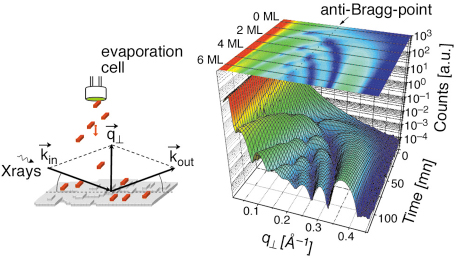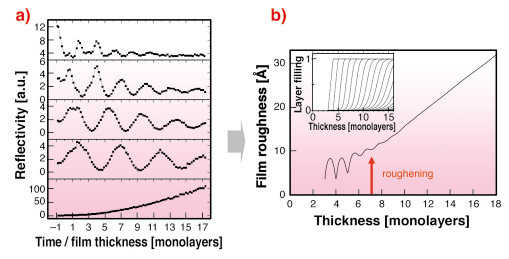- Home
- Users & Science
- Scientific Documentation
- ESRF Highlights
- ESRF Highlights 2006
- Soft Condensed Matter
- Watching organic crystalline films grow
Watching organic crystalline films grow
Organic semiconductors have attracted much attention in recent years as they offer potential for low cost, large area, and flexible (opto-) electronics. Organic materials are also interesting from the perspective of growth physics, as organic molecules have vibrational, conformational, and orientational degrees of freedom which influence their growth behaviour. Therefore, in a recent experiment at beamline ID10B, in situ and real-time measurements were performed during evaporation of the organic semiconductor diindenoperylene (C32H16, a red dye). These X-ray experiments yield insight into the evolution of surface roughness and the evolution of competing crystal structures. Importantly, real-time measurements give information which would be missed in post-growth experiments, such as information on post-growth de-wetting of the film or transient structures existing only for a short moment during growth.
The X-ray reflectivity and diffraction experiments were performed at beamline ID10B, using a portable ultra high vacuum growth chamber which allows in situ measurements during organic molecular beam deposition of the organic semiconductor diindenoperylene.
In one set of experiments we used time-resolved grazing incidence diffraction to follow Bragg reflections of two different crystalline structures with molecules that are i) standing upright or ii) lying down. The data show that on silicon oxide substrates the molecules already stand upright in the very early stages of growth. Interestingly though the first monolayer exhibits a transient structure which disappears when more molecules are heaped upon the first monolayer (transient strain).
When the substrate temperature is lowered (< 30°C) or a substrate with stronger van-der-Waals interactions (i.e. a ‘stickier’ surface such as gold) is used, the molecules start to lie down more and more on the substrate.
In a second set of experiments we acquired the specular reflectivity (see schematic of scattering geometry in Figure 48) to measure growth oscillations, which give information on the filling of individual crystal layers during growth. Commonly growth oscillations are measured at the anti-Bragg point (q = 1/2 • qBragg = 1/2 • 0.37 Å-1) where consecutive crystalline layers interfere destructively resulting in an oscillating reflected intensity.
 |
|
Fig. 48: Organic molecular beam deposition is used to grow thin films of the organic semiconductor diindenoperylene. During growth the specular X-ray reflectivity is acquired in real-time not only at the anti-Bragg point, but in a wide q-range. |
To get a better understanding of the complex growth behaviour of organics, in this work we have developed a method to acquire and analyse real-time growth oscillations not only at the anti-Bragg point, but in a wide q-range, i.e. a large number of Fourier components are sampled simultaneously (Figure 48). Following the time evolution of the reflectivity at fixed q-values such as q = 2/3 • qBragg , q = 3/4 • qBragg , … growth oscillations with a longer period are visible (Figure 49a). Importantly the damping of growth oscillations at these q-values is lower than the damping at the anti-Bragg point, so that it is possible to follow the crystalline growth up to larger film thickness. From a combined fit of these growth oscillations at different q-values the evolution of layer coverages and the film roughness can be extracted as shown in Figure 49b; the data show that a pronounced transition from layer-by-layer growth to rapid roughening occurs after ~ 7 monolayers of diindenoperylene have been deposited. While the driving force for this transition is not clear, the model results indicate a significant drop in interlayer transport. Several factors may contribute to this decreased transport such as faster nucleation, a decreased diffusion, and an increased Schwoebel barrier for thicker films.
 |
|
Fig. 49: a) Time evolution of the reflectivity at fixed q-values: the anti-Bragg, 2/3-, 3/4-, 4/5- growth oscillations and the Bragg intensity are shown. b) The evolution of crystalline layer coverages and the film roughness, deduced from (a). The growth shows a pronounced transition from layer-by-layer growth to rapid roughening after 7 monolayers. |
In conclusion we have used in situ and real-time X-ray scattering to follow the development of different crystal structures and the consecutive filling of crystal planes during the growth of organic thin films. We have identified a roughening transition in diindenoperylene growth after deposition of about 7 monolayers. As growth is a dynamic phenomenon, real-time measurements in a wide q-range are required for a comprehensive picture of the growth kinetics. In our experiments, changes in growth mode and transient structures were revealed, which would be missed in post-growth experiments.
Principal Publication and Authors
S. Kowarik (a, b), A. Gerlach (a, b), S. Sellner (b), F. Schreiber (a, b), L. Cavalcanti (c) and O. Konovalov (c), Physical Review Letters 96, 125504 (2006).
(a) Physical and Theoretical Chemistry Laboratory, University of Oxford (UK)
(b) Institut für Angewandte Physik, Universität Tübingen (Germany)
(c) ESRF



